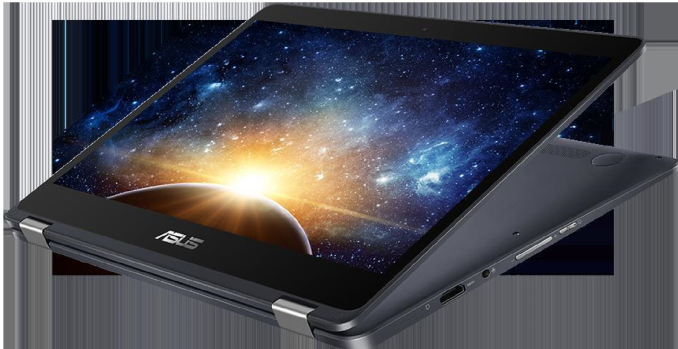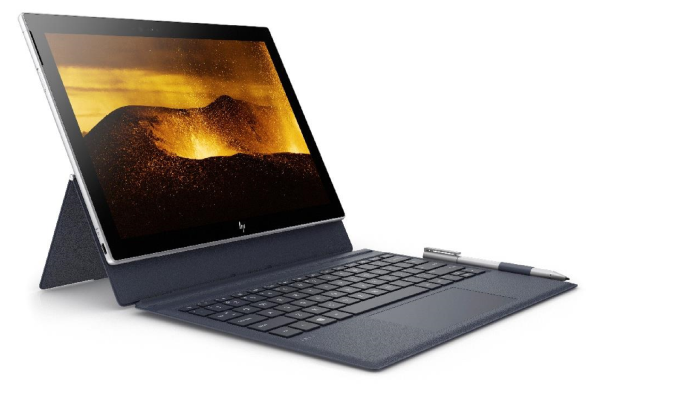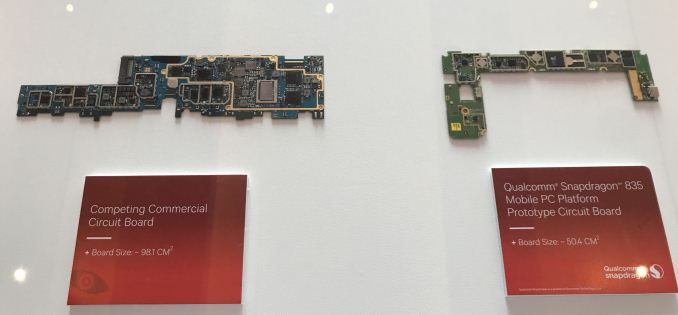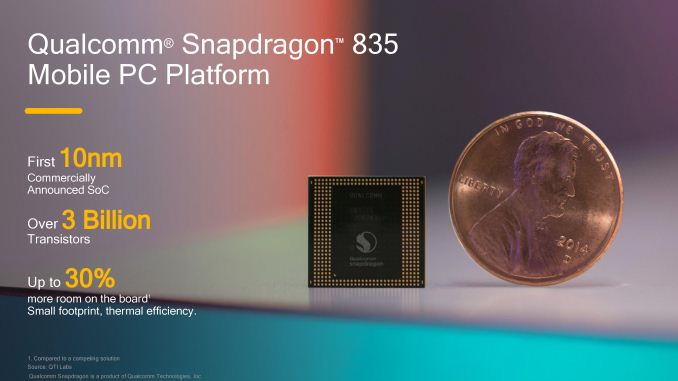Microsoft Launches Windows 10 On ARM: Always Connected PCs
by Brett Howse on December 5, 2017 2:30 PM EST
This morning at the Qualcomm Snapdragon Summit in Hawaii, Microsoft’s EVP of Windows and Devices, Terry Myerson, is announcing the introduction of the first Windows 10 PCs to be powered by Qualcomm Snapdragon processors. It was almost a year ago to the day that the company first announced their partnership with Qualcomm, which would bring ARM support to Windows 10, but with x86 emulation, allowing all existing applications to work as well. The first PCs will be the ASUS NovaGo, which is a convertible laptop, and the HP ENVY x2 convertible tablet.
This is exciting news on a couple of fronts. The Qualcomm Snapdragon 835, which was the processor first announced for Windows 10 on ARM, offers reasonable performance, but with lower power consumption than what we’ve been used to in the PC space, and especially in low-power states. Without having the devices in-hand, we still don’t know how the SD835 compares in performance to the competition. We should finally be able to answer that soon though.
One of the key pieces of using a mobile SoC in a PC is the extra integration. Smartphones don’t have room for large circuit boards, while still providing room for all of the other equipment and batteries required, and mobile SoCs offer a lot more features integrated into the SoC than what a typical PC would, which allows for substantial board space savings over the competition. Back at Computex, Qualcomm was showing off the SD835 PC board compared to a competing 14nm Intel board, and the space savings were up to 30%. This allows smaller, thinner, and lighter devices, but with more battery capacity.
One of the major integrations with the SD835 compared to PC SoCs is the integrated cellular connectivity, which is one of the features that Microsoft is championing the most with this new partnership. There have been PCs with cellular cards added on for some time, but Qualcomm’s cellular tech is aimed at mobile, where always-on connectivity, and low-power usage, is a requirement. That same connectivity will be available on the PC as well, with an always-connected network connection providing a better user experience than what we’ve become accustomed to in the laptop world.
Battery life should also be a big win, and while we don’t have our own tests done yet, Microsoft’s information is claiming up to 30 days of standby and up to 22 hours of active use, while the detachable tablet-style HP ENVY x2 is claiming up to 20 hours of active use. That’s impressive, and blows past the all-day battery life that we’ve come to expect in a laptop, and should free a device up for a couple of days of use before charging. Terry Myerson has stated that he’s been getting up to a week of use out of a device before he needs to charge it.
The always-on nature of mobile brings other advantages too. The PCs will wake up instantly, just like you’d expect on your phone, or mobile tablet.
The ARM equipped devices will be running full Windows 10, so no desktop apps are left behind, unlike the previous time that Microsoft attempted this. The ARM chips at the time offered much less performance as well, so this time around, it should be a much better experience. Universal Windows Apps will be available compiled for ARM directly, but x86 apps will run in emulation, which is still a cause for concern for both performance and battery life, so we’ll have to see how that pans out. Microsoft has an “optimized” version of Office 365 for the new ARM powered PCs, which likely means it’s been recompiled for native performance.
Perhaps the most exciting part of the announcement is what added competition in this space should bring to the end-user. We have Qualcomm coming to the PC from the mobile space, where low-power has always been key, but the performance has been improving steadily, and we have Intel and AMD on the other side, coming from a high-performance but higher-power world, where integration of components into the SoC hasn’t been as high of a priority. It’ll be interesting to see where the convergence happens in the coming months.
Source: Microsoft














59 Comments
View All Comments
Cygni - Tuesday, December 5, 2017 - link
Running x86 through an emulation wrapper layer, through a low performance CPU, for a premium laptop price. Nearly as bad as the Surface RT.I mean I know Microsoft needs to keep Intel honest, and they need to have Windows running on ARM, but this is a dud of a product at the price.
ikjadoon - Tuesday, December 5, 2017 - link
Have you seen the benchmarks? Have you used one? Were you there at the event? Did you watch the livestreaming of them running Photoshop?Cygni - Tuesday, December 5, 2017 - link
Yeah-yeah, I see your cheerleading posts all over this board. Regardless of performance claims and the magic of "chippies", I will remain completely skeptical and sure as heck am not going to take staged demonstrations as indicative of real world performance. Cmon its 2017 and you are still buying that crap?Even buying Microsofts claims, again, why would you pay mid-market laptop prices for a laptop that is "near native" in its code performance for everything you will run? Entering the market with the value proposition of "yeah its worse than everything its price competitive with thats also already available everywhere, but its just a LITTLE worse!" is a recipe for failure for MS. Again.
ikjadoon - Tuesday, December 5, 2017 - link
Yeah, yeah: it's called being up to date. It's like all of you just heard about this today. "Oh, God, emulation." "Oh, God, Windows RT." "Oh, wow, Atom/Celeron! My panties are already twisted. What a fail."Get a grip; you'll should have already read the emulation walkthroughs, the Snapdragon 835 architecture and platform review (written on Anandtech), and
Eh, sure: please, don't you dare buy anything until you see benchmarks. Actually, you better never buy one until you've actually used it. I plead you: don't buy them now. Don't buy them until you see reviews. Don't buy them--don't you dare--until you can use one for some time. No cheerleading--but the emulation/Windows RT junk is worthless and outdated. Y'all pick up buzzwords and attack. Take a step back. And hold tight, ;)
Why? Because of battery life, Cygni. Come on, now. You can't be presuming to ignore every claim of "man, I wish it had better battery life" from laptops. Or maybe you like to carry your power cord for your laptop. I don't know.
Again--"near-native"--my dudes, my dudes, my dudes. You are not--and will never be--the target market of these devices. If you're looking for the highest performance in a $800 laptop and will forgo expected ~50% to 75% battery life hit, you are a small part of the market.
It's better than everything its price competitive with in battery life. Full stop. If you think laptops have "good enough performance", but not "good enough battery", then this is for you. But if you're upset or frustrated with laptop performance, don't you dare touch this device. Don't waste your money. Don't waste your time. Don't touch them.
These won't beat an i5 or an i7 in CPU-bound benchmarks. Or GPU-bound benchmarks. Never. Impossible. From a 5W SoC? Get outta here--ridiculous. But, you know what? A lot of people don't care about 1.5s vs 1.0s loading, yet they care a lot more about 10-hours vs 22-hours of battery life.
ikjadoon - Tuesday, December 5, 2017 - link
*and at least other, independent benchmarks of ARM on Windows besides those offered by Qualcomm & MS over the past 5 years.Manch - Wednesday, December 6, 2017 - link
Yeah, yeah, benchmarks by the people peddling the product! I'll wait as should you too. Read the independent reviews. Come on, seriously, have you used one? Where you there at the event? Or are you just so excited and wishing this to be true that any naysayer on here has committed the ultimate sin of pushing in on your reality distortion field.I was a huge fan of Windows phone. I loved the idea of one OS to rule them all. MS failed RT, they failed Windows Phone, abandoned it and their userbase. Destroyed Nokia from the inside while they were at it. This seems like another side project that I question whether or not it will take off. I remain skeptical and will wait for independent reviews and benchmarks. At the price they're asking, until I know what kind of performance I can expect along with that battery life, and they can show me how this is better than an android tablet or anything else on the market, Ill remain as skeptical as everyone else.
Seriously , how many times have we heard x86 emulation that just works come out before? Until there is proof this is just a reinvented broken wheel.
lazybum131 - Tuesday, December 5, 2017 - link
Asus and HP launching a 13.3" flip laptop and a 12.3" tablet 2-in-1 just shows the conservative nature of PC manufacturers, where it actually makes less sense since Intel Core CPUs are competitive in this space (in that battery life is okay and performance is good with Intel solutions).Microsoft is gonna need Surface products to push these guys into other form factors just like they did with the Surface Pro line. Give me a premium 8" tablet with 12+ hr battery life that I can dock and use as a home PC. Intel gave up in this space after Cherry Trail, with 4-6 hr battery life and terrible performance.
Hurr Durr - Wednesday, December 6, 2017 - link
Maybe now I can have a new phone.leo_sk - Wednesday, December 6, 2017 - link
Is it confirmed that they will support and allow installation of win32 apps (outside the store)?Meteor2 - Wednesday, December 6, 2017 - link
Yes.